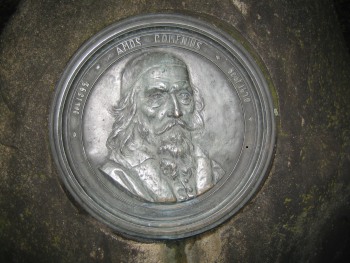While Hiding In Cold And Dangerous Woods
By Christian Overman in Worldview Matters, October 5, 2012
John Amos Comenius (1592-1670) is a giant among reformers. He is to today's schools (including American schools) what Martin Luther was to the church.
Like Luther, Comenius experienced his share of suffering. His innovative school in Bohemia was burned, along with his books. His house was also burned, and his property was taken. Some of the nearly ninety books he wrote on the topic of education were written while hiding in cold and dangerous woods.

|
|
This likeness of John Amos Comenius is embedded into a stone in Berlin, Germany.
(Photo used via Creative Commons Attribution-Share Alike 2.0 Germany license.) |
Although Comenius was born in today's Czech Republic, and did much of his work there, he also worked in Holland, Sweden, Poland and Hungry. In addition, he responded to a request from the English Parliament to come to that country to reform their system of public education, and he also helped start the first modern university at Halle, Germany. This university later merged with Luther's university to form the Wittenberg-Halle University. Today, the Comenius Medal, awarded by UNESCO, honors outstanding achievements in educational research and innovation.
Vishal Mangalwadi, in The Book That Made Your World, maintains that William Wilberforce, William Carey and other significant 18th and 19th century culture-makers, "were following Comenius, even if some of them were not conscious of it. Not only modern India, but also modern America was shaped by Comenious's vision. The difference is that the pioneers of American education knew the debt they owed Comenius. They invited him to come to the new world to head up their new college, Harvard, in New England. Comenius's optimism through education had such a profound impact on some Puritan settlers in America that they chose to become an educational community before becoming a commercial or industrial nation."
Comenius provided a foundation for Noah Webster's views on education. He was the prime mover in what historians call the Encyclopædic movement [or the Pansophic movement] in education. This was a movement that provided a driver for the curriculum of early Harvard and Yale, which lasted for 150 years (but is gone today).
